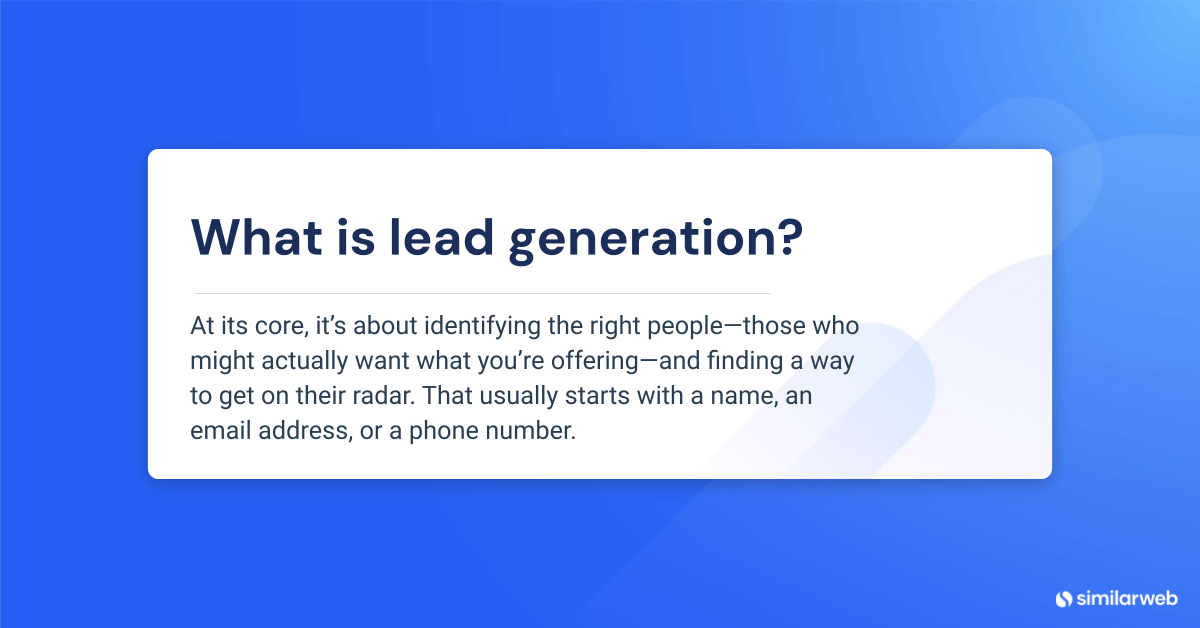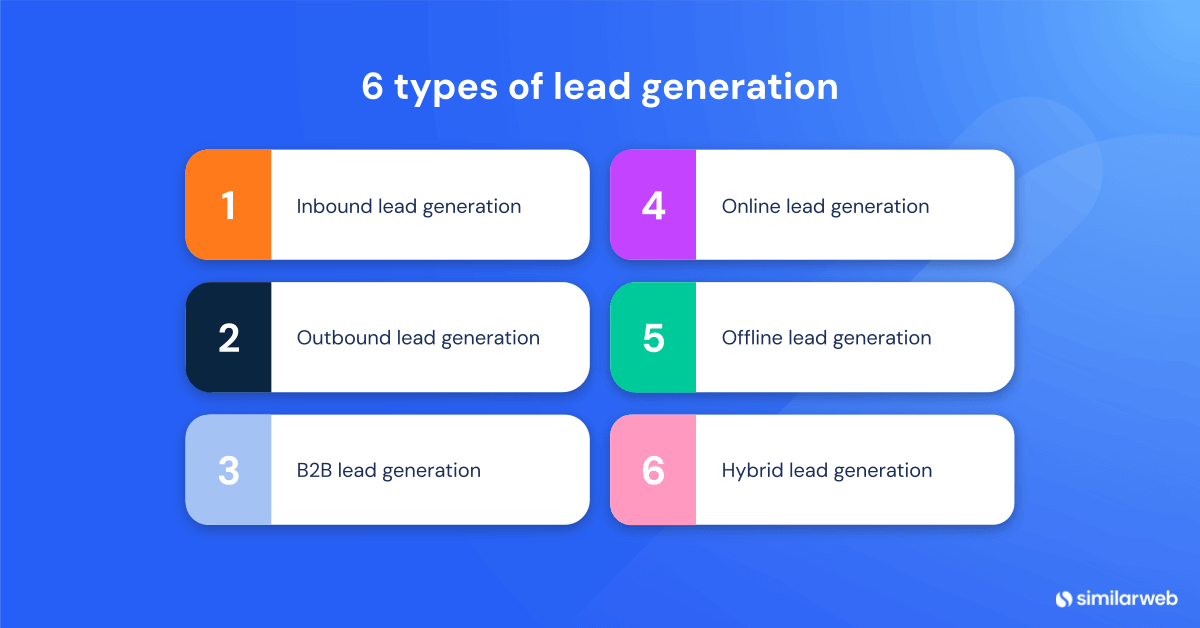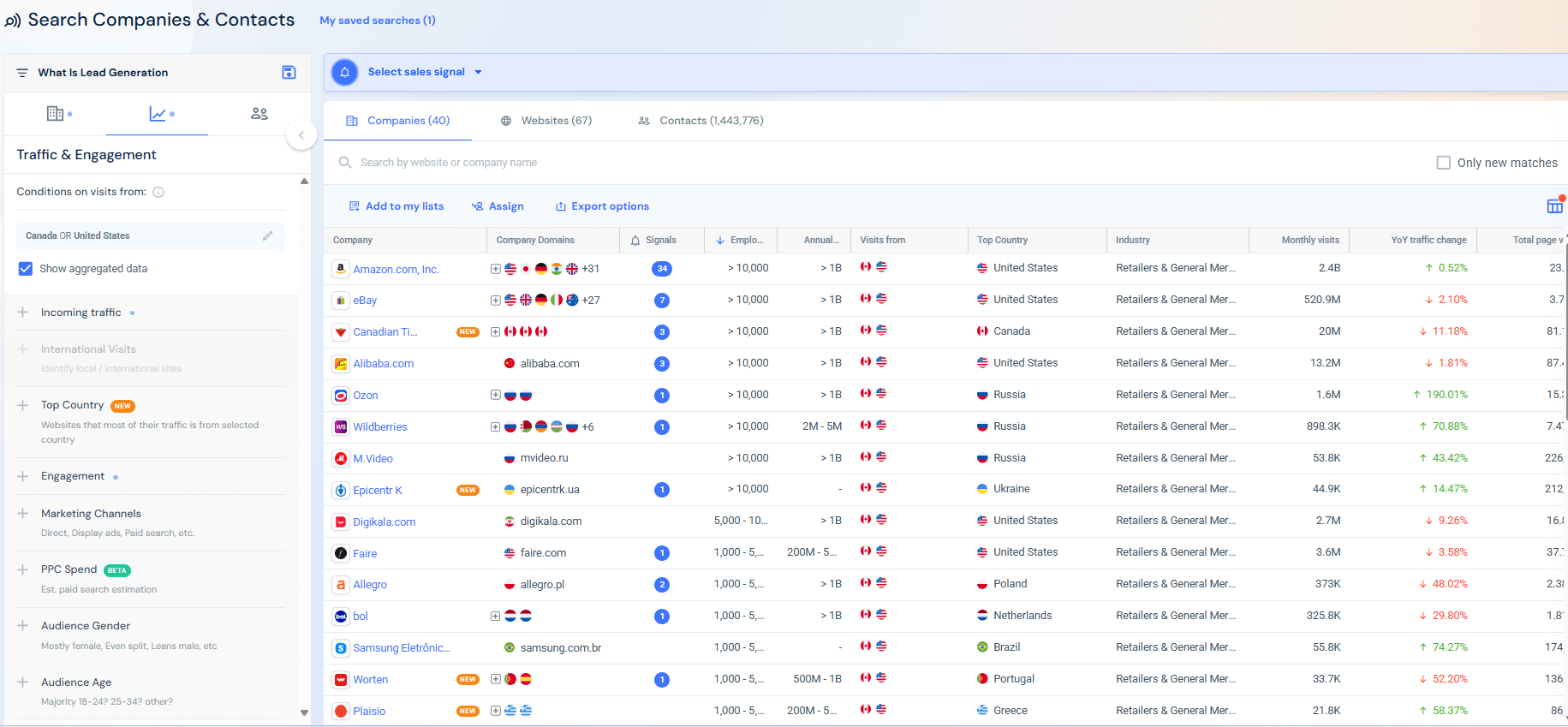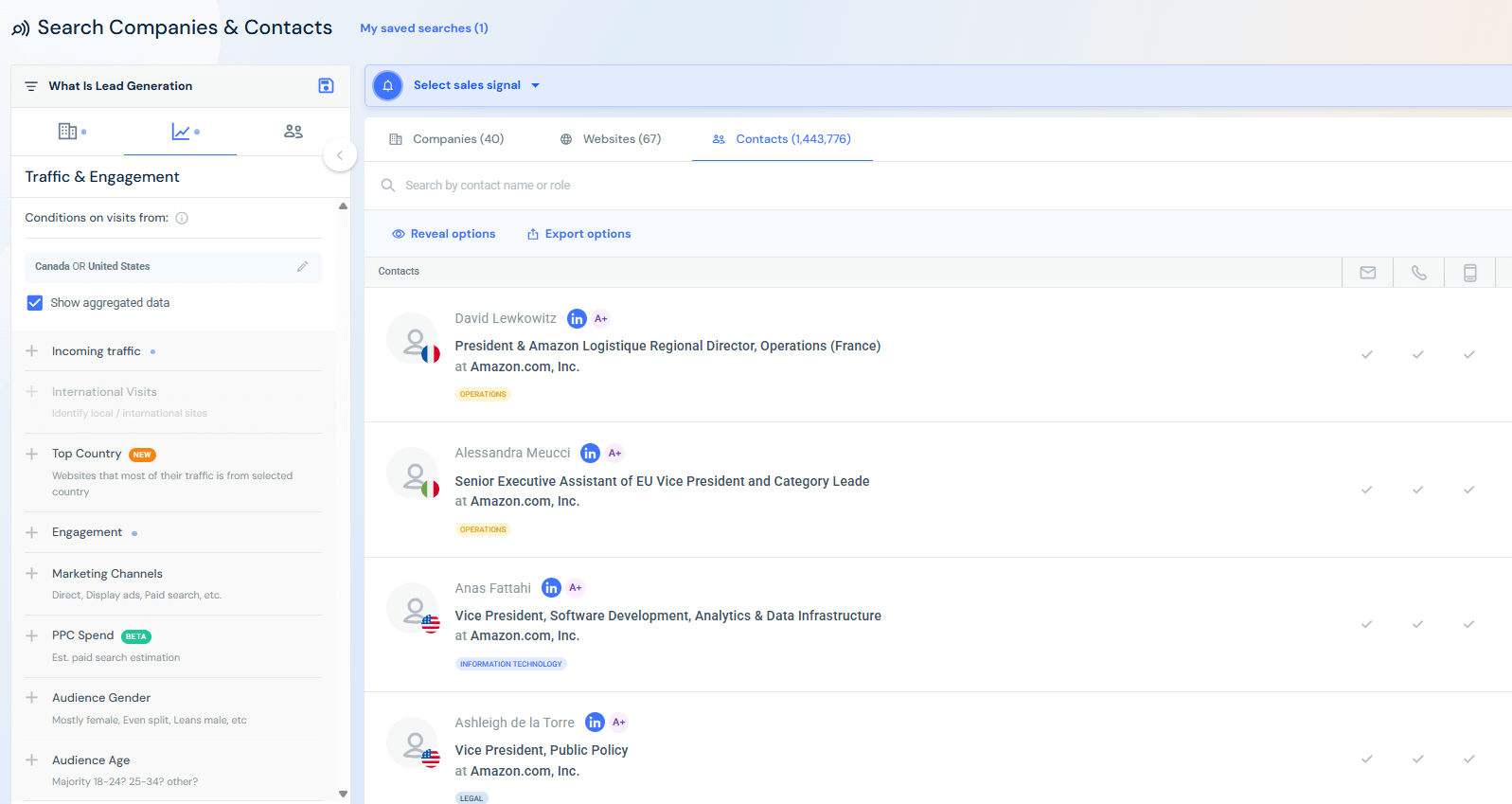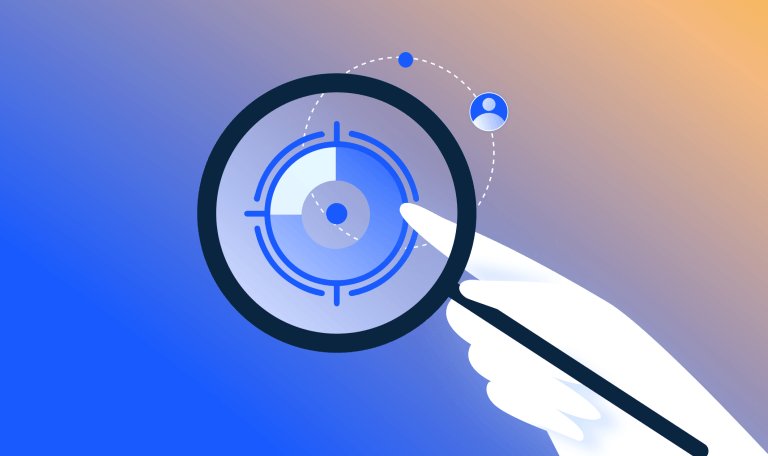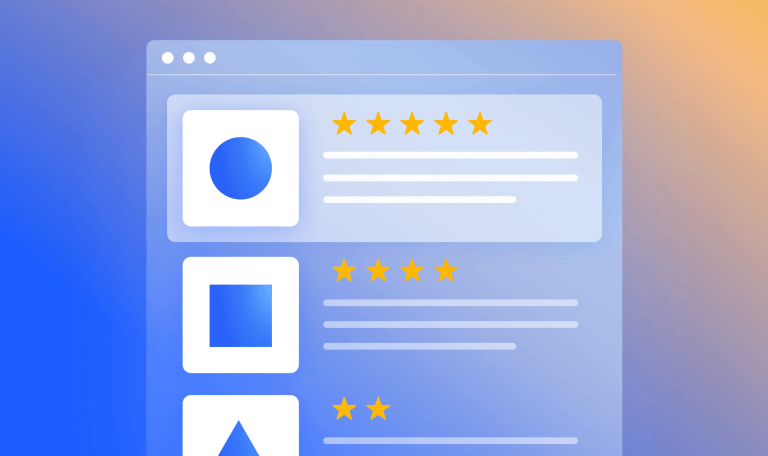What is Lead Generation? 6 Main Types

Lead generation is the fuel behind long-term growth and customer acquisition. If you’re in the business of selling anything (and let’s be honest, who isn’t?), you need to know how to generate leads, why it matters, and what tools can make your process faster, smarter, and more adaptable.
If you’re trying to understand what lead generation actually means or looking for ways to tighten your sales funnel, this guide is for you. You’ll find answers to questions like:
- What is lead generation in sales?
- What is a lead generation process and how does it work?
- Which tools can help you scale faster?
You’ll get practical insights that plug straight into your workflow, like how a keyword generator can help you improve outreach, how traffic intel on the top websites and apps reveals demand trends, and why pairing a lead enrichment tool with a reliable sales engagement platform can lift your entire strategy.
Want to go even further? Add in sales intelligence and a reliable AI sales assistant to work smarter at every touchpoint.
Let’s discuss the fundamentals, and show how tools like Similarweb can give you the upper hand in finding (and converting) the right leads.
What is lead generation?
Lead generation is the art (and science) of turning interest into opportunity.
At its core, it’s about identifying the right people, those who might actually want what you’re offering, and finding a way to get on their radar. That usually starts with a name, an email address, or a phone number. But what matters more is how you get there.
So, what is lead generation in sales? It’s the process of guiding strangers into your funnel and converting curiosity into a pipeline. Sales teams use content, paid ads, SEO, outreach, webinars (the list goes on) to bring leads in. Then they segment, score, and nurture them until it’s time to pass the baton to sales.
Real lead generation is about quality. What will you do with 10,000 leads if none of them are going to convert?
Effective lead generation relies on targeting, timing, and tailored messaging. Use the right data, personalize your outreach, and connect at the right moment, and suddenly, you’re catching leads and no longer chasing them.
Why is lead generation important?
Lead generation is the engine behind sustainable growth, and if you get it right, everything else flows from there.
Here’s why it deserves a front-row seat in your strategy:
It drives real revenue
When you generate quality leads, you’re targeting people who actually want what you’re offering. These are prospects primed to convert.
This often leads to more sales, higher revenue, and much less guesswork.
This is what lead generation really means in sales: knowing who’s ready to buy and showing up at exactly the right time.
It saves money, and makes your budget work harder
There’s no need to throw money at cold audiences. When your lead generation is on point, every dollar works smarter.
Target the right people, cut the fluff, and watch your ROI go up. That’s why lead generation is financially a must if you want to scale with purpose.
It gives you better customer intelligence
Want to know what your buyers are thinking? Start by capturing the right data.
Every form fill, download, and click tells a story. This information helps you understand who your customers are, what they need, and how to speak their language. That means more relevant campaigns, and stronger user interaction across the board.
It lets you personalize like a pro
Lead generation lets you segment your audience and tailor your message accordingly. With traffic analysis tools and behavioral data in hand, you can send the right content to the right people, at the right moment.
That kind of precision is what turns interest into action.
It improves your brand visibility
The more your leads see you, the more they trust you. Consistent, high-value user interaction helps cement your brand in the minds of potential buyers. Over time, you’re the go-to in your space and not just another vendor.
And in a noisy market, that trust gives you an edge.
It builds long-term loyalty
True lead generation starts a relationship.
The best strategies nurture leads beyond the first sale, into loyal customers who come back, spend more, and refer others. That’s how you turn a pipeline into a growth engine.
6 types of lead generation
There’s no one-size-fits-all when it comes to lead generation. What works for one business might completely flop for another. That’s why knowing the different types of lead generation, and when to use them, matters.
Here are the six tried-and-tested methods. Each one has its strengths, depending on your audience, your goals, and how you want to show up in the market.
1. Inbound lead generation
This is the art of pulling people in, without chasing them down. Inbound lead generation is all about creating value that attracts your ideal prospects naturally. Think blogs, SEO, webinars, and those social media posts that hit just the right nerve.
Your goal is building trust. Giving people answers to the questions they’re already asking. It’s a slow burn, but one that delivers long-term returns.
If you’ve ever Googled a question and clicked on a helpful post? That’s inbound doing its job.
2. Outbound lead generation
Now let’s flip the script.
Outbound lead generation means taking the first step. It’s cold emails. It’s smartly timed calls. It’s direct mail done right. You’re reaching out, literally and not waiting around. And when you target the right people with the right message, it can work fast.
Yes, it’s more interruptive. But done with precision and personalization, outbound can cut through the noise and grab attention. Bonus points if it works hand-in-hand with inbound, nudging warm leads who just need a little extra push.
3. B2B lead generation
So, what is B2B lead gen?
Simple: it’s lead generation that speaks to businesses and not individual buyers. That means longer sales cycles, more stakeholders, and content that goes deep, not wide. We’re talking whitepapers, events, and value-packed LinkedIn posts that position your brand as the go-to in your space.
It’s about intent and building relationships that convert over time.
4. Online lead generation
Most action happens these days on the internet, and online lead generation is how you tap into that. Whether it’s a killer landing page, a high-performing PPC campaign, or a scroll-stopping Instagram ad, the goal is the same: attract and convert.
What makes it powerful? Data. You can track, tweak, and improve every step of the funnel. If it’s working, you’ll scale it.
It’s agile, it’s measurable, and it lets you meet people exactly where they are, on their screens.
5. Offline lead generation
Not everything happens online. Offline lead generation brings it back to the real world. Trade shows, meetups, conferences, these are high-touch opportunities to make connections the old-fashioned way.
Yes, it’s harder to track with analytics. But it’s also harder to ignore when done well. Nothing beats a face-to-face handshake for building trust. Use it to reinforce your online presence, and bring a human side to your brand.
6. Hybrid lead generation
This one’s the best of both worlds.
Hybrid lead generation mixes inbound with outbound. Online with offline. Content with cold outreach. It’s about using every tool at your disposal to meet people on their terms.
You might run an ad to a webinar, follow up with an email, and seal the deal over coffee. That’s hybrid. It’s flexible, and, when coordinated properly, extremely effective.
If you want reach, relevance, and results, hybrid’s the playbook.
How Similarweb helps you generate leads
Similarweb’s Lead Generation and Qualification module turns raw web traffic data into a curated pipeline. The platform covers more than 20 million companies and 370 million contact profiles, so prospect discovery scales with your goals.
Choose the industry, traffic range, geography, and configure the metrics to produce a live company list that matches your ICP. Each result carries fresh traffic, engagement, and technology data that hint at current buying intent.
Move to the Contacts tab and filter the list by seniority or function to surface direct emails and phone numbers of decision-makers.
Implement a more efficient and targeted lead generation strategy
Lead generation is the engine behind your growth. And if you’re serious about scaling, you need to understand what it is, why it matters, and how to do it better.
Start by getting familiar with the six core lead generation types, everything from inbound to hybrid. Each one has its strengths, but not all of them will fit your market. Pick a strategy that matches how your buyers actually behave.
That’s where Similarweb enters the picture.
With access to traffic insights, competitive benchmarks, and reliable sales intelligence, you’re making informed decisions based on hard data. Whether you’re optimizing your funnel or narrowing your targeting, Similarweb gives you the visibility to build a lead gen engine that works harder, and smarter.
Ready to tighten up your strategy and focus on what moves the needle? Use the right tools, and the rest follows.
FAQs
What is B2B lead generation, and how’s it different from other approaches?
B2B lead generation zeroes in on businesses. That means everything from your messaging to your outreach needs to speak the language of decision-makers. It’s about building relationships. Compared to B2C, the sales cycles are longer, the stakes are higher, and the tactics, think industry content, account-based marketing, and events, are tailored for organizations.
How do lead generation tools actually increase sales?
Think of lead gen tools as your behind-the-scenes sales team. They automate the grunt work, finding prospects, scoring leads, tracking behaviors, so your actual team can focus on closing. These tools connect the dots across your CRM, email platform, and ad campaigns to make sure you’re reaching the right people.
What’s sales intelligence got to do with lead gen?
Everything. Sales intelligence is the fuel that powers smarter lead generation. It pulls information from behavior, market shifts, and firmographic data. Want to hit the right person at the right time with the right message? Sales intelligence is how you do it. Plug it into your lead gen strategy and watch your precision, and results, go up.
Boost your consultative selling impact
Try Similarweb Sales Intelligence today — free of charge





